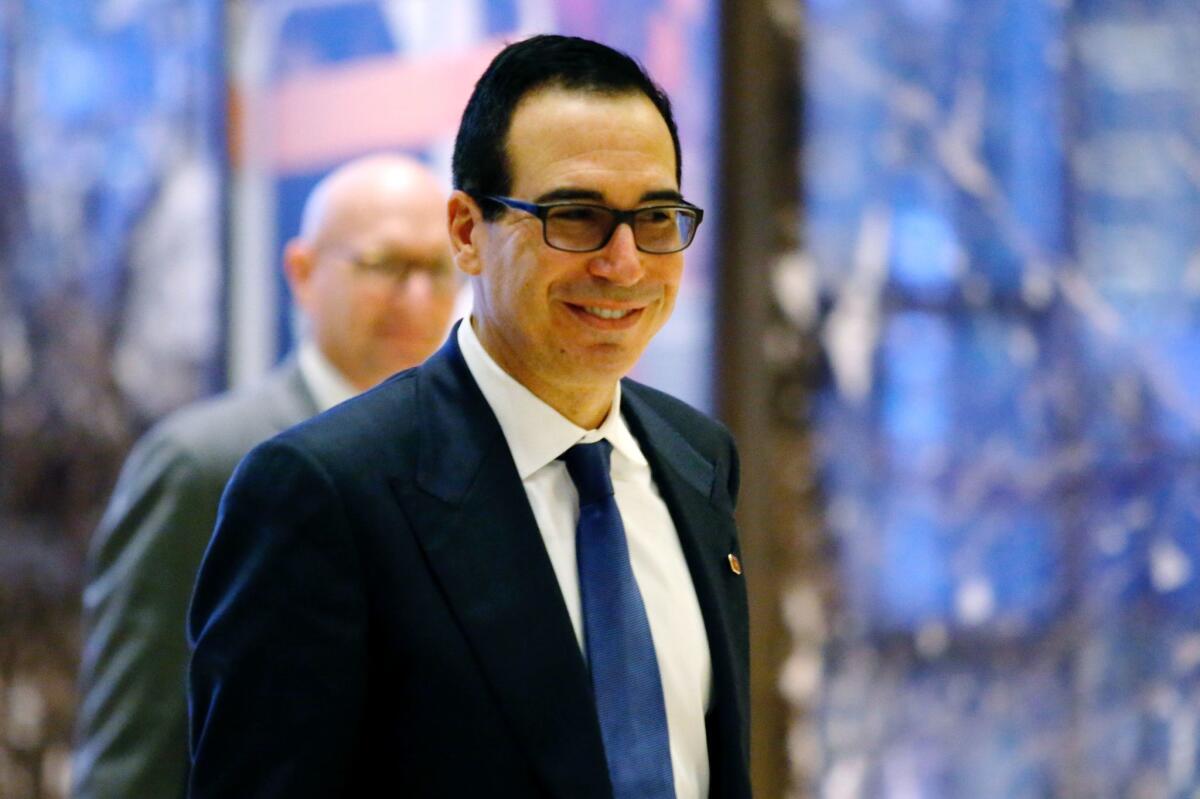In forging a budget deal, Pelosi found a Trump official she can work with

- Share via
WASHINGTON — The budget deal signed into law by President Trump on Friday marks his administration’s first major bipartisan legislative agreement with the Democratic House, a deal crafted by the unlikely duo of Speaker Nancy Pelosi (D-San Francisco) and Treasury Secretary Steven T. Mnuchin.
The agreement — which will raise the nation’s debt ceiling and lift caps on federal spending — came together largely because almost everyone in Washington wanted the deal.
The stakes of failure were high. But Trump left the negotiating to one relatively apolitical Cabinet official, and the final pieces came together as Pelsoi negotiated on a cellphone while she was on a delayed airplane that sat on the Detroit airport tarmac for more than three hours.
In the end, the agreement averts the crisis — both financial and political — of the country risking defaulting on its debt until after the 2020 presidential race. It also allows lawmakers to spend more money over the next two years and probably eases the path toward funding the government later this year.
For Pelosi, the deal marks an accomplishment that falls into her legislative wheelhouse as an appropriator and a vote counter. She got the deal passed on the House floor with 219 Democrats — one more than needed and including some moderates and progressives — as well as 65 Republicans.
For the relatively low-profile Mnuchin, the deal averts a fiscal crisis on his watch.
“Mnuchin — he is a secret weapon right now,” said Sen. David Perdue (R-Ga.), a Trump ally. “We all have constituents on both extremes who don’t like this deal, which means we probably found a middle-of-the-road compromise.”
The agreement also marks a visible shift in the relationship between Senate Republicans and the White House. Senate Majority Leader Mitch McConnell (R-Ky.) and Pelosi agreed early on that they wanted a deal. But having been burned in the past by the president’s sudden shifts, McConnell left the negotiating to her and the White House. He understood that even if he and Pelosi wrote a deal, it would be meaningless without the president’s political approval. Senate Republicans learned how to weigh in on the talks quietly, while allowing the administration to take the lead.
It’s too early to know whether this is a breakthrough that could lead to other bipartisan agreements, such as on a prescription drug plan or approval of the revised NAFTA trade pact called the USMCA. It may be a one-off pact to raise spending limits at the behest of nearly all lawmakers in Washington and push the issue beyond the next presidential election.
The seed of a deal came together in a May meeting between Pelosi and McConnell. Former appropriators, they each hated the handcuffs of a 2011 budget deal that restricted federal spending. Plus, they both saw value in lifting the debt limit without a battle that would eat up weeks of time, carry political consequences and risk the nation’s credit.
Talks began slowly between congressional leaders and administration officials. But by mid-June, they were at a crossroads.
GOP senators, including many defense hawks, worried that the slow-moving talks and a lack of interest from the White House in a long-term deal were putting a budget deal out of reach.
Without an agreement, funding would remain at lower levels, leaving defense spending significantly below what many GOP senators wanted. Ringing in their ears was a late-2018 warning from then-Defense Secretary James N. Mattis that there had been a surge in training-related military deaths, which outpaced combat deaths, according to a Republican senator.
They were worried that some White House officials — namely acting Chief of Staff Mick Mulvaney and acting Office of Management and Budget Director Russell Vought — were happy to not make a deal and keep funding levels at their current rates in what’s known as a continuing resolution, or “CR.”
“There was some frustration early on by our appropriators that some people in the room from the White House — probably Mick and Russ were the two — were happy with a CR,” said one GOP senator who didn’t want to be named discussing the talks. “The military was coming to us and saying, ‘That’s a disaster.’”
They urged Trump and administration officials to cut a deal. Perdue and 16 other senators decried the “draconian conditions” that would result from no agreement.
“While some members of the administration have suggested a yearlong CR as a viable path forward, this must be avoided,” they wrote in a letter to Mnuchin, Mulvaney and Vought.
“We purposely didn’t send it to the president,” Perdue said, “because the president was saying the same thing we were saying: ‘Hey, I want a budget deal. You guys get off your backsides and get a budget deal.’”
At the same time that Senate Republicans were trying the steer the negotiation toward a deal, Pelosi made a key decision to row in that direction as well. She narrowed in on Mnuchin as the best and perhaps only administration official she wanted to negotiate with.
The Treasury secretary walked into a meeting of administration and congressional leaders in Pelosi’s office in mid-June and made overtures that she recognized as ones that meant he was serious about a deal. “We’re prepared to stay here” all day to get an agreement, he said, according to a person familiar with the meeting.
Mulvaney, on the other hand, left the same meeting and told reporters that Pelosi said she would only increase the debt ceiling if Trump boosted spending levels. The comments infuriated Pelosi, who publicly said that Mulvaney had twisted her comments and that he had “no credibility” on the debt ceiling, pointing to his votes against raising it while he was in Congress. The day all but put an end to the idea of a Mulvaney-Pelosi deal. But Mnuchin called back later that day to resume the discussions.
From that day on, Pelosi and Mnuchin put “blinders” on to focus on crafting a compromise, as one observer put it. He was “operational, never political,” the person said.
Mulvaney, according to one person who spoke with him about the matter, was OK with having Mnuchin take the lead in negotiating the budget agreement. The acting White House chief of staff, a former member of Congress who railed against spending, accepted the president’s ultimate calculation that it was “in his best interest not to have a spending fight before the election,” the person said. “It’s a terrible deal from a Republican standpoint, but in the end you had to get it done, and Mnuchin had the better background for it.”
Mulvaney, despite his reputation as a fiscal hawk, didn’t push back on the president’s decision as much as other GOP allies on Capitol Hill, including members of the conservative Freedom Caucus and Sen. Rand Paul (R-Ky.), who urged the president to fight for a budget with deeper spending cuts.
Pelosi, as well as others looped in on the talks, had to put their faith in Mnuchin that he could speak for the president.
“The president knew him, had some trust in him. It’s imperative,” said Sen. Richard C. Shelby (R-Ala.), chairman of the Senate Appropriations Committee. “Secondly … he was concerned as the secretary of the Treasury, with the full faith and credit of the financial system.”
Negotiations intensified in the coming weeks, with Pelosi and Mnuchin speaking by phone at least every day but often several times per day.
During the talks, Mnuchin lobbied for a commitment for a vote on the new trade deal. But Pelosi shot it down, saying, “If you want to kill two birds with one stone, that’s the way to do it,” according to a source familiar with the conversation. Axios published a story last week that Mnuchin told colleagues that Pelosi agreed to hold a vote in October. But a spokesman for Pelosi said it is not true.
Eventually, Pelosi and Mnuchin signed off on a plan to set up $1.37 trillion in spending next year and slightly more in the following year, resulting in $320 billion in new spending above the limits previously set in law. The debt ceiling won’t need to be raised until about mid-2021.
The plan gives a larger increase to non-defense spending than defense spending, a win for Democrats.
As part of the agreement, the four congressional leaders made a handshake deal that as they enact spending bills to correspond with the funding levels, they would not attach any new “poison pills,” such as new abortion or border wall language. While there is no legislative language attached to the agreement, all four congressional leaders — particularly Republicans — have touted it as a win that could make the appropriations process easier this fall.
The agreement was nearly final when a flight delay postponed it a bit longer. Pelosi handled several of her last phone calls — a conversation with Mnuchin, one with Senate Minority Leader Charles. E. Schumer (D-N.Y.) and another with the other top congressional leaders — on seat 23D of a delayed Delta flight at the Detroit airport. The phone was “pressed to her ear for much of the last three hours,” according to a tweet by a CNN reporter who was on the same flight.
The delay lasted so long that most passengers deplaned. Pelosi, her staff and security detail — as well as a young child traveling alone — stayed on the plane as she participated in the phone calls.
By the time she landed in Washington, Trump had announced the agreement via Twitter. A few progressives voiced opposition to moving the new debt ceiling limit to 2021, giving Republicans a potential cudgel in the first months of what could be a new Democratic president’s term. And they expressed worry that the president will be able to move money around to fund his priorities, namely the border wall. But ultimately they relented, and nearly all Democrats in both the House and Senate voted for the package.
Conservatives and budget hawks grumbled about new spending and the elimination of the 2011 caps known as sequestration, an effort to limit federal spending. Paul called it “the death of fiscal conservatism.”
But unlike during the government shutdown, Trump appeared unmoved by their arguments. He has rarely balked at spending more money.
Instead, he tweeted his support for the plan immediately before the House and Senate voted. He and the White House lobbied senators ahead of the vote, hoping to decrease the number of GOP defections.
In the end, a majority of House Republicans voted against the deal and it passed in the GOP-controlled Senate with more Democratic votes than Republicans one. Typically that might prove an embarrassment, but Trump hailed the vote, just happy he got his deal.
More to Read
Get the L.A. Times Politics newsletter
Deeply reported insights into legislation, politics and policy from Sacramento, Washington and beyond. In your inbox three times per week.
You may occasionally receive promotional content from the Los Angeles Times.












